Lubricants for the nuclear power industry
Jeanna Van Rensselar, Senior Feature Writer | TLT Feature Article September 2015
Proper lubrication selection, sampling, analysis and evaluation have become more and more important.
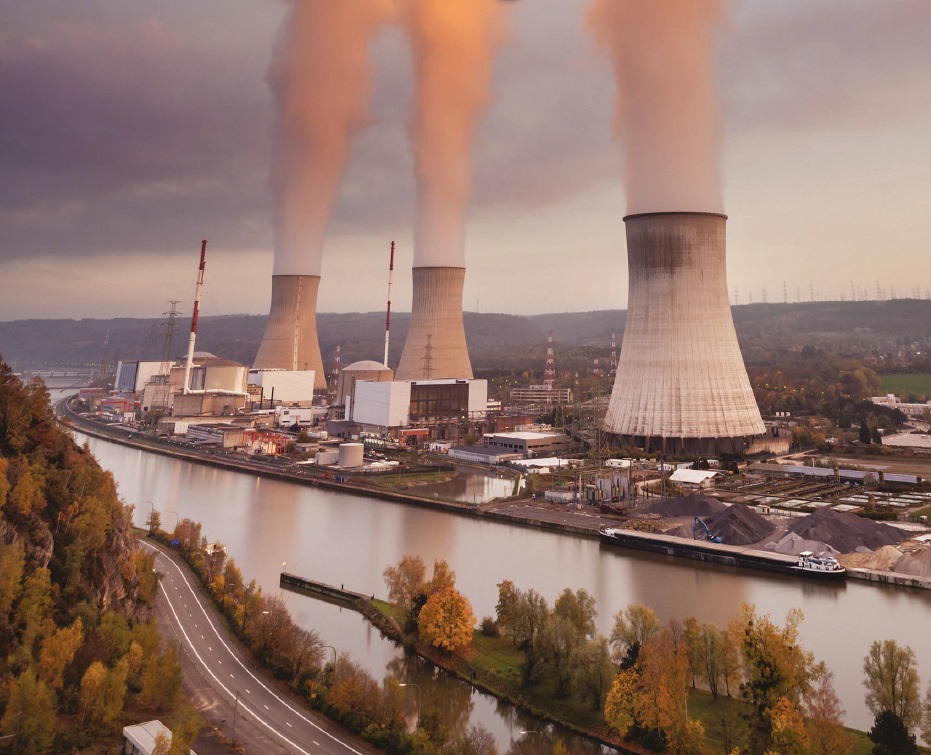
www.canstockphoto.com
KEY CONCEPTS
•
Cost estimates for nuclear plant construction have risen to $9 billion, partly due to the expense of rigidly overseeing all components, including lubricants.
•
There are a daunting number of processes and procedures that must be completed to change a lubricant formulation in a nuclear power plant.
•
Radiation exposure can cause significant changes to lubricant properties.
THE DOEL NUCLEAR POWER STATION IS ONE OF TWO NUCLEAR POWER PLANTS IN BELGIUM. It employs about 800 workers and spans 200 acres. Doel is located in an area that is more densely populated than any area around any other nuclear power station in Europe (nine million inhabitants within a 47-mile radius—about the same as the Greater Chicago area).
On Aug. 5, 2014, Doel was unexpectedly taken offline due to a loss of lubrication in the main steam turbine. The turbine suddenly overheated after its oil was completely depleted. Rather than a leak, it turned out that a padlock-secured valve was opened, which rapidly drained all 65,000 liters of oil to an underground storage tank (deliberate worker sabotage has not been ruled out). The unplanned automatic shutdown caused significant damage to the turbine, which remained down for about four months. Although the incident occurred in a non-nuclear area of the power station, the shutdown contributed to a significant energy shortage in the area it served.
The incident points to the need for fire-resistant lubricants, gravity-feed emergency lubrication oil supplies and the need for turbine trips based on smart level controllers that will detect a rapid loss of oil.
Lubricants in nuclear energy facilities are a concern for a number of reasons. There are stringent demands on some lubricants’ cooling capabilities and they must be able to retain their properties when exposed to radiation. But an even bigger concern is the issue of quality control.
The U.S. nuclear industry has about 400 domestic and 160 additional global parts suppliers—lubricants are considered parts. The risk of introducing incompatible lubricants is high in many industries, but this is especially true for nuclear energy facilities. Even the slightest formulation change has to be documented and pass a rigorous vetting process.
Experts say that most supply chain problems are actually found at the design level (in the case of lubricants that would be the formulation level) and involve contractors or subcontractors who don’t take requirements seriously (
1).
ABOUT NUCLEAR ENERGY
The principles behind nuclear power plant operation are similar to fossil-fueled power plants: fuel turns water into steam, which drives turbine generators to produce electricity (
see Figure 1). The difference is the source of heat. At fossil-fuel plants, the combustion heats the water. But there is no combustion in a nuclear reactor; rather the heat to make the steam is created when uranium atoms split (fission). In the U.S., there are two types of nuclear reactors:
•
Pressurized water reactors (PWRs). These keep water under pressure so that it heats but does not boil. The heated water is then circulated through a network of pipes in the steam generators, where the water is turned into steam and turns the turbine generator. Water from the reactor and the water that is turned into steam are in separate systems and do not mix—an important difference between PWRs and boiling water reactors.
•
Boiling water reactors (BWRs). These heat the water via fission in the reactor. Unlike PWRs, the water actually boils and turns into the steam that turns the turbine. In both PWRs and BWRs, the steam is turned back into water and can be used again in the process.
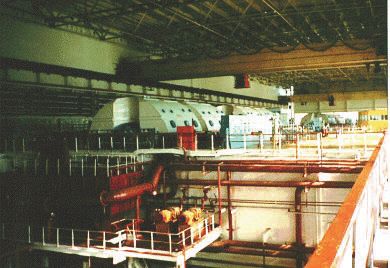 Figure 1. The oil system used for lubricating the bearings on the turbine. (Photo courtesy of J.A. Gonyeau, from NuclearTourist.com.)
Figure 1. The oil system used for lubricating the bearings on the turbine. (Photo courtesy of J.A. Gonyeau, from NuclearTourist.com.)
A Canadian deuterium uranium (CANDU) reactor is a form of PWR. The major differences include the use of horizontal pressure tubes that contain the fuel and the use of a heavy water moderator in which a deuterium isotope replaces hydrogen in the water molecules.
In the U.S., about two-thirds of the reactors are PWRs. There is no data showing that one type is safer than the other—each camp has its own proponents. One Global Spec blogger compared the issue to the Edison vs. Tesla DC vs. AC debate (
2).
BRIEF HISTORY
Shortly after World War II, U.S. Admiral Hyman Rickover championed the idea of using nuclear reactors to power submarines. The idea was pure genius since the ships would never need to refuel or use oxygen for combustion (
3).
Then in 1951, on a little farm in Idaho, an experimental liquid-metal cooled reactor dubbed
EBR-I was attached to a generator to produce the first nuclear-generated electricity for domestic use. In 1957, the first commercial reactor in the U.S. (Shippingport) fired up.
Throughout the 1960s and 1970s, nuclear reactors proliferated throughout the U.S., Europe and (what was then) the Soviet Union. At one point, France was getting about 75% of its energy from nuclear reactors. The frenzy peaked in 1979 just before the Three Mile Island accident. Enthusiasm waned further after the 1986 Chernobyl accident.
Both of these incidents resulted in tighter regulations that promoted safety, but drove construction costs up significantly (
see sidebars titled Deterministic Safety Analysis and Probabilistic Safety Analysis). In 1994, the U.S. signed the Megatons to Megawatts treaty with Russia. One of the treaty’s provisions was the
down-blending of nuclear weapons into reactor fuel. At one point, 10% of U.S. electricity was coming from dismantled nuclear weapons (
6).
DETERMINISTIC SAFETY ANALYSIS (4)
Deterministic safety analysis focuses on evaluating the consequences of various events to confirm that the dose acceptance criteria are met. In the case of nuclear power plants, RD-310, Safety Analysis for Nuclear Power Plants, sets out the requirements related to safety analysis, including the selection of events to be analyzed, acceptance criteria, safety analysis methods and safety analysis documentation and review. The objectives of deterministic analysis given in RD-310 include the following:
1.
Confirm that the design of the facility meets design and safety requirements
2.
Derive or confirm operational limits and conditions that are consistent with the design and safety requirements for the facility
3.
Assist in establishing and validating accident-management procedures and guidelines
4.
Assist in demonstrating that safety goals, which may be established to limit the risks posed by the facility, are met.
The licensee is responsible for identifying and classifying a set of events that covers all credible accident sequences for the facility. These events are identified through a variety of methods, including probabilistic analysis.
PROBABILISTIC SAFETY ANALYSIS (5)
Probabilistic safety analysis focuses on evaluating the risk arising from various events in order to confirm that safety goals are met. In the case of nuclear power plants, the requirements for probabilistic safety analysis are provided in regulatory standard S-294, Probabilistic Safety Assessment (PSA) for Nuclear Power Plants. The objectives of the probabilistic safety analysis are to:
1.
Evaluate the frequencies of severe accidents to the core (for nuclear reactors) and of severe releases, and compare them to the safety goals
2.
Evaluate the effect of facility or operational modifications on the frequency of accidents
3.
Evaluate the effectiveness of defense in depth
4.
Evaluate the impact of post-accident management on the frequency of releases.
Probabilistic analyses are performed using best estimate data and assumptions, and consider all existing plant systems in order to provide a realistic risk prediction.
Concerns about global climate change in the 1990s and the lack of further catastrophes, such as those at Three Mile Island and Chernobyl, spurred renewed interest in nuclear energy. Nuclear reactors were built and operated without incident until March 2011 when a large earthquake and tsunami led to an adverse nuclear incident at Japan’s Fukushima Daiichi nuclear power facility.
CURRENT STATE
Right now nuclear energy accounts for 19.4% of all the electrical energy produced in the U.S. There are currently 440 nuclear reactors worldwide. With a total of 99, the U.S. has more reactors than any other country (
7). The country with the second highest number of reactors is France with 58. Russia has 34 and China has 24 (
8). The Santa Maria De Garona reactor in Spain, along with reactors at Fukushima in Japan, are in long-term shutdown. In part because of the nuclear incident in Japan, Spain is currently in the process of phasing out nuclear energy as are other countries (
9).
The U.S. is the world’s largest producer of nuclear power, accounting for more than 30% of worldwide nuclear-generated electricity. There are currently 71 new reactors under construction in the world, with five of these in the U.S. But the lower cost and abundant supply of natural gas has caused some companies that are considering construction of additional nuclear generation facilities to rethink the projects. The astronomical cost of building these plants and the questionable payback is one area that nuclear detractors seize on. Between 2002 and 2008, for example, cost estimates for new nuclear-plant construction rose from between $2 billion and $4 billion per unit to $9 billion per unit (
11). Part of the cost is the expense of increasingly rigid oversight on all components, including lubricants.
The future of nuclear energy facilities is about a lot more than how many will or won’t be built (
see sidebar titled Environmental Benefits of Nuclear Energy). It’s also about how and when to decommission existing facilities built in the 1970s and 1980s. The initial license period for most of these facilities was 40 years, with one or more 20-year extensions.
ENVIRONMENTAL BENEFITS OF NUCLEAR ENERGY
There is a vigorous debate about the safety and benefits of nuclear power. Those in favor, including the World Nuclear Association, the International Atomic Energy Agency, Environmentalists for Nuclear Energy and the Nuclear Energy Institute (NEI) contend that nuclear power is a safe, sustainable energy source that reduces carbon emissions. Benefits that NEI cites include (
10):
•
Clean air. Because they do not use fossil fuel to generate heat, nuclear facilities produce no greenhouse gases or carbon emissions associated with air pollution.
•
Climate change initiatives. Carbon mitigation strategies developed by Princeton University, Columbia University’s Earth Institute, Harvard University and the Pew Center on Global Climate Change concluded that reducing the greenhouse gases that lead to climate change is going to depend on the expansion of low-emission electricity sources, including nuclear power.
•
Ecology. Nuclear energy has one of the lowest impacts on the environment of any energy source because it does not emit air pollution; it isolates its waste from the environment and requires a relatively small amount of land.
•
Lifecycle emissions analyses. Nuclear energy’s lifecycle emissions are comparable to renewable forms of electricity generation, such as wind and hydropower.
Palo Verde Nuclear Generating Station engineer Bryan Johnson adds, “Working as a lubrication engineer at a nuclear power plant is a very environmentally friendly position. Extending machine service life and reducing machine friction along with the energy needed to operate the equipment is an important part of my role. This in turn is beneficial to the environment. Nuclear power produces clean energy that supports our modern societal lifestyle, without leaving a carbon bill to be paid in the future.”
LUBRICANTS IN NUCLEAR POWER FACILITIES
According to STLE-member George Staniewski, senior technical expert in the Engineering Support Division of Ontario Power Generation, there are two main principles involved in the selection of lubricants:
1.
The original equipment manufacturer’s (OEM) recommendation based on design calculations and operating experience
2.
Consolidation of the number of lubricants to minimize the number of different suppliers, purchase arrangements and handling processes.
For critical equipment applications, the engineering group at the nuclear facility prepares a purchase specification. During this process, the lubrication engineer has a chance to participate in the discussion on lubrication-related issues including the type of lubricant, the type of the lubrication system and the engineer’s specific requirements.
For less critical applications, the OEM-recommended lubricant may be substituted with the same lubricant type provided by a different supplier. Approval of the substitution is based on an analytical comparison between the two different lubricants, which includes, but is not limited to:
•
Comparison of base oil type and API group
•
Additive types and OEM-specific recommendations regarding compatibility with elastomers or paints or other specific requirements
•
Physical and chemical properties of both fresh lubricants
•
A compatibility test (if the change is related to in-service equipment).
Staniewski says, “Theoretically, in our organization anybody may recommend a change of lubricant, but it is the duty of the lubrication engineer to perform the thorough analytical review and make the final recommendation to management. Grease replacement is more complicated and usually OEM recommendations are accepted. In general, we avoid changing the grease thickener type, but if this must be done an extensive compatibility test is performed.”
The most common lubricant type is R&O oil, which is used primarily in the steam turbine and many light-duty conventional and nuclear applications. The second most common type is hydraulic fluid with antiwear additives; this is used in applications where there is a requirement for preventing asperity-to-asperity contact during mixed or occasional boundary lubrication.
The third most common type is gear oil, which is used in most gearboxes and actuators. Other oils include compressors oils, gas turbine oils, transformer fluids and special fluids such as fire-resistant phosphate ester fluids for steam turbine electro-hydraulic systems or fuels for diesel engines and gas turbines.
Typical greases used at nuclear power plants include polyurea, calcium sulfonate and lithium complex. In addition, there are specialty products used during assembly processes. These include lubricants for elastomers, thread lockers, sealants, adhesives, anti-seize compounds and cleaning agents, either as a liquid, paste, powder or aerosol.
To minimize misapplication, each Ontario Power Generation station has an electronic lubrication database that is controlled by a lubrication engineer. Each lubricant used at the station has the current material safety data sheet (MSDS) available in the electronic database for all station staff.
During the nuclear power plant design process, engineers consider certain accidents, called Design Basis Accident (DBA) scenarios. In the unlikely event of a DBA, the selected equipment and components must operate to safely shut down the reactor and provide continuous cooling to remove the decay heat from nuclear fuels. If lubricant is required in such equipment during DBA conditions, the lubrication engineer at the nuclear power plant must ensure that the selected lubricant can provide the required design function (
see sidebar titled The Lubricant as a Design Component). Usually this requires arranging a special thermal aging and irradiation test.
THE LUBRICANT AS A DESIGN COMPONENT
At Palo Verde, they treat the lubricant as a design component. Bryan Johnson, Station Lubrication engineer, says, “The lubricant specified for use is considered to be part of the machine design. We treat a change in lubrication the same way we would if the design of the machine had changed.”
He points to a motor replacement for comparison: If the specification of the motor changes, it is a design change. So as system components, lubricants would be no different.
Steve Lopez, plant engineering section leader at Palo Verde, adds, “Addressing lubricants as a design component rather than a maintenance commodity allows for a greater level of review and control of their use consistent with Quality Assurance Program requirements. The challenges that creates are that it requires more engineering, supply chain and maintenance time to review, approve, procure and control these lubricants in a rapidly changing marketplace that does not always promptly and accurately advise the customers of pending changes.”
“We apply very strict control in lubricant selection and handling processes to minimize the potential for misapplication of lubricants,” Staniewski says. “In addition, during bulk oil delivery, there is a quality control step at the station to check the critical parameters prior to transferring the oil or fuel from the tanker to the station’s temporary storage tank.”
ADDITIVES
The criticality of the additive in the lubricant is dependent on the specific application and current operating environment. The concentration of the most critical additives is monitored directly or indirectly during oil analysis. In critical applications, the lubricant is changed frequently to ensure that if an accident happens, the lubricant will perform its design function. Because of this close monitoring, additive levels are very rarely depleted.
In other applications—such as steam turbine oils—which are in the systems for more than 20 years, regular makeup with fresh oil (usually up to 5% annually) provides satisfactory conditions assuming the filtration systems are in continuous operation. In addition, the steam turbine oil is drained from the reservoir every 10 years and the reservoir is cleaned.
Although the in-use addition of a fresh additive package is not recommended, Ontario Power Generation has done this in the past. This process included extensive testing of the in-service oils to determine each additive concentration. The concentrated package included anti-foam additives, oxidation inhibitors and a metal deactivator. This entire process was performed under the oversight of the oil manufacturer.
RADIATION CONSIDERATIONS
Radiolysis of lubricants is generally not a problem in nuclear power plants. It takes radiation doses above those prevailing in normal plant operations to make appreciable changes in lubricant properties. An accident scenario may produce high enough radiation exposure to cause significant changes to lubricant properties. However, in the event of an accident, lubricated equipment does not have to operate long or be maintained and most of the equipment is very tolerant of viscosity changes in lubricants (
12, 13).
In general, the overall effect of radiation is similar to thermal exposure. Both accelerate oxidation. Color change occurs first, indicating the beginning of oxidation and other structural changes. Gas evolution will also take place followed by changes in viscosity. The final product of very high thermal or radiation exposure is an intractable solid. Radiation effects are directly related to the radiation energy input. In general, the more complex the lubricant, the less tolerant it is to radiation.
The physical effect on greases is that they mostly soften with initial exposure, reflecting degradation of their sensitive gel structure. Eventually this is followed by hardening as the effect of the oil components takes over. Although most greases used at nuclear power plants will remain stable under conditions of moderate radiation, some commercial greases will harden or soften in those conditions.
Usually aromatic compounds, because of their poor viscosity/temperature properties, are deliberately removed from mineral base oils. However, aromatic compounds can be designed through synthesis to have good radiation-resistant properties. Such materials are employed in making lubricants for maximum radiation resistance. The introduction of a phenyl group additive will improve radiation resistance.
In nuclear reactors, cobalt-containing materials are removed by wear and/or corrosion and can circulate through the reactor and become radioactive. This increases the overall radiation levels making operation, maintenance and disposal issues more complicated. As a result, cobalt-free materials are used (
14).
THE EFFECT OF RADIATION ON ELASTOMERS
Most lubrication systems have elastomeric seals, gaskets and/or hoses. Bearings may have nylon retainers or seals in sealed-for-life bearings (
see Figure 2). Elastomers are roughly 10 times more sensitive to radiation than lubricants. Some elastomers show degradation when exposed to relatively low levels of radiation. One of the more common elastomers for use with water and steam is ethylene propylene rubber, but it is not suitable for use with many mineral oils because it can swell. Because of this, extra diligence is required when specifying elastomers. Elastomer selection includes not only suitability for a specific function, but also what chemicals it might be exposed to during service and/or maintenance (
15).
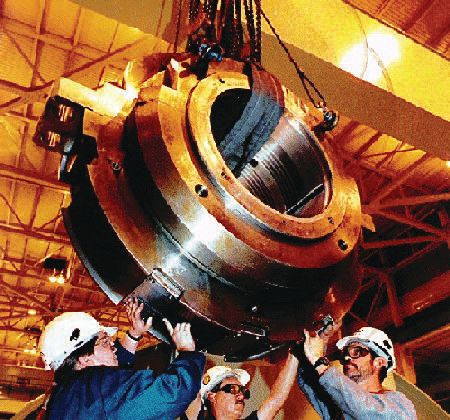 Figure 2. A bearing being removed from a turbine. The bearing supports the shaft. There are two bearings for each high and low pressure turbine unit. The bearing vibration and temperature are monitored continuously during plant operation. (Photo courtesy of Nuclear News.)
OTHER ISSUES
Figure 2. A bearing being removed from a turbine. The bearing supports the shaft. There are two bearings for each high and low pressure turbine unit. The bearing vibration and temperature are monitored continuously during plant operation. (Photo courtesy of Nuclear News.)
OTHER ISSUES
Stress corrosion cracking (SCC) can be of concern, especially with the extensive use of austenitic stainless steels and high-strength alloy steels in nuclear power plants. Insulation materials, dye penetrants, and lubricants all promote SCC. Also, anti-seize pastes must be chosen with care. The compounds of concern can depend on whether the application is wet or dry, with MoS
2, being restricted in wet environments.
The failure of a number of turbine discs was attributed to the use of MoS
2 during assembly. Similarly, there have been issues with mild steel and low-alloy bolts because of boric acid corrosion (
16).
FORMULATION CHANGES
At Ontario Power Generation, the lubricant selection process includes an independent hazmat review. When the new lubricant is approved by engineering, a unique catalog number is assigned for each package size and the appropriate supplier is contacted for a price quote.
Staniewski explains, “It is important to recognize that some of the critical lubricants such as steam turbine lube and seal oils, fire resistant fluids, transformer oils, lubricants for safety-related equipment and fuels have their own purchasing specification describing the minimum requirements for critical parameters and the content of required test results performed by the lubricant manufacturer prior to shipment.” Preference is always given to the primary lubricant supplier.
Staniewski continues, “In 1994, our organization reviewed all potential lubricant suppliers and selected the preferable supplier based on several different factors such as the range of available lubricants, local accessibility of products, research and technical support, training capabilities and cost structure. One of the critical benefits for the lubricant supplier is access to our operating experience as well as our studies on thermal and irradiation exposure that are usually not performed by lubricant manufacturers.”
In the commodity agreement there is also a clause requiring written documentation on any changes to the current lubricant formulations prior to actual change. This allows for appropriate assessment and database modification.
For safety-related lubricants, both Ontario Power Generation and the lubricant supplier participate in a verification study on the stability of critical properties during thermal aging and irradiation exposure as well as on compatibility between the existing lubricant and the new formulation.
Engineer Bryan Johnson with Palo Verde Nuclear Generating Station (near Tonopah, Ariz.), says, “We expect the local oil supplier to inform us if their product is changing. It would be best to obtain this information when the local supplier is notified by the manufacturer. If this protocol isn’t followed, we will test newly received products onsite to determine if a formulation change has occurred. We include this testing as part of our receipt inspection process. A viscosity test, metals by spectrometer and a direct comparison of FTIR spectrum provide this information.”
THE LUBRICANT BUYER’S PERSPECTIVE
As the senior chemical buyer, Glenda Lorenz is in charge of procuring lubricants for Palo Verde. She says that most suppliers are diligent about notifying her of any formulation change, but this is not always true for smaller changes.
“They may not realize that even the smallest change has an impact on whether or not we can receive the reformulated material,” she explains. “If the supplier doesn’t notify me of the change, then the material will be quarantined in the warehouse until the issue has been resolved.”
While a formulation change is a fairly simple matter for other industries, in the nuclear power industry, it is a big deal. There are a daunting number of processes and procedures that must be completed and followed before the replacement lubricant is accepted.
“This process can take anywhere from a couple of days to months, and in some cases years to be completed,” says Lorenz. At Palo Verde, participating departments include engineers, QC inspectors, environmental, procurement engineering, lube labs, lube engineering, the requesting department and supply chain (
see Figure 3).
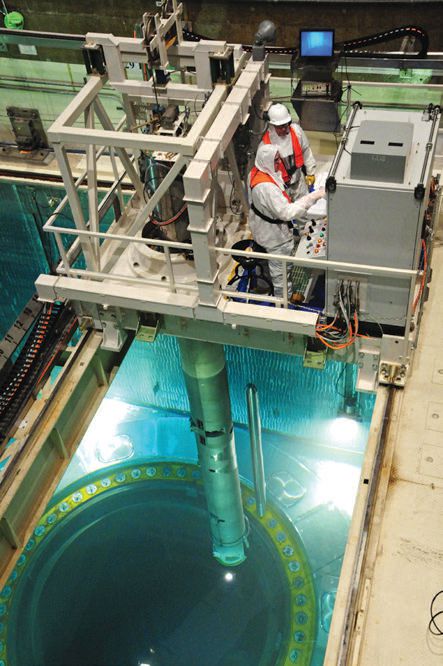 Figure 3. Palo Verde refuel personnel coordinate a recent core reload in the unit Control Room and Fuel Building. Each of Palo Verde’s three units has approximately one-third of its 241 fuel assemblies replaced with new assemblies during refueling outages that take place about every five years in each unit. (Photo courtesy of Palo Verde Nuclear Generating Station.)
Figure 3. Palo Verde refuel personnel coordinate a recent core reload in the unit Control Room and Fuel Building. Each of Palo Verde’s three units has approximately one-third of its 241 fuel assemblies replaced with new assemblies during refueling outages that take place about every five years in each unit. (Photo courtesy of Palo Verde Nuclear Generating Station.)
At Palo Verde, certain chemicals can only be purchased from approved quality suppliers that have undergone an audit of their quality programs. The process could include a more stringent audit.
Lorenz adds that a couple of years ago, a major manufacturer made drastic changes to its parts numbers, descriptions and formulation changes in order to be globalized. “Meetings were held between Palo Verde and the supplier to verify and approve the changes,” she says. “All material had to be tested to verify whether or not it had indeed changed, and if it had changed then new MSDS and part numbers had to be generated and approved. The end-users had to be notified of the changes as well. This change has taken a couple of years to complete.”
MAINTAINING LUBRICANTS
Condition monitoring of lubricated equipment can include a variety of methods, including observation and inspections, functional testing, stroking with diagnostics for motor-operated value actuators, vibration testing, thermography and oil analysis. Grease condition monitoring is less common, but assessments are often made on the condition of the grease in motor-operated value actuators using a combination of appearance, smell and tactile observations.
The extent and type of condition monitoring to be performed depends on the importance of the equipment and whether or not it can be accessed during operation. If the equipment is located in the reactor building, oil samples or other readings might only be available at 18-month intervals. Sampling during operation is feasible, but is more difficult and exposes a worker to higher doses of radiation.
Another consideration for testing is the residual radiation content of the lubricant samples. While the levels are generally low, some test procedures require more handling and/or higher temperatures, which generate more fumes. As a result, some test equipment might have to be located in hot cells, which limits the tests that can be performed.
Steve Lopez, plant engineering section leader at Palo Verde, explains, “The unique monitoring and maintenance elements that can be attributed to the use of lubricants at nuclear generating stations are primarily in the area of control, verification, evaluation, documentation and qualification of the practitioners (
see sidebar titled Maintenance Rule 10CFR50.65).”
MAINTENANCE RULE 10CFR50.65
The Maintenance Rule (10CFR50.65) for U.S. Nuclear Stations became effective in 1996. There have since been changes and updates. But the original objective, which is unchanged, is to ensure that important systems in nuclear stations are capable of performing their intended functions and that failures resulting in automatic reactor shutdowns and unplanned safety system activity are minimized. To comply, nuclear power station operators must regularly monitor systems and components to demonstrate the effectiveness of their predictive, preventive and corrective maintenance—and routine condition monitoring programs to prevent failures. In the event of a failure, the Maintenance Rule requires that the cause is determined and that corrective actions are implemented (which would necessitate more in-depth lubricant analyses).
He continues, “The nuclear industry also has a robust program for oversight, lesson sharing and operating experience sharing to provide higher confidence levels that defense in depth is integrated into the processes. The goal is that any potential errors are promptly identified and corrected before they affect plant operations. Proper lubrication selection, sampling, analysis and evaluation have become more and more important as companies attempt to optimize their operations in rapidly changing marketplaces—where the need to extend the lifecycle of plant equipment assets and optimize the use of resources becomes more essential.”
While the operating conditions in nuclear power facilities are comparable to those in other facilities’ operating steam-powered generators, the difference is the grave consequences of radiation leaks.
Staniewski concludes, “At our organization, the lubrication program is part of an equipment reliability program to ensure that we are capable of generating electricity in an affordable and sustainable manner (
see Figure 4). It is important to recognize that a successful lubrication program should be integrated with other station programs to be effectively implemented and sustained.”
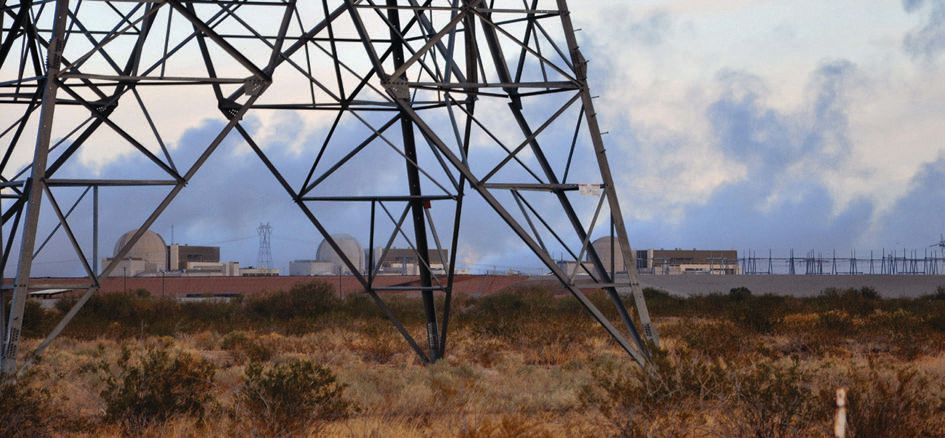 Figure 4. Palo Verde’s mission is to safely and efficiently generate electricity for the long term. The three units generate enough electricity for more than four million customers in the Southwest U.S. Palo Verde area, and directly and indirectly supports an estimated 8,800 jobs and has an annual economic impact on the Arizona economy of $1.8 billion. (Photo courtesy of Palo Verde Nuclear Generating Station.)
REFERENCES
Figure 4. Palo Verde’s mission is to safely and efficiently generate electricity for the long term. The three units generate enough electricity for more than four million customers in the Southwest U.S. Palo Verde area, and directly and indirectly supports an estimated 8,800 jobs and has an annual economic impact on the Arizona economy of $1.8 billion. (Photo courtesy of Palo Verde Nuclear Generating Station.)
REFERENCES
1.
From Supply Chain and Procurement Issues – ANS Annual Meeting 2013: Available
here.
2.
From
here.
3.
The USS Nautilus launched in 1954 as the first nuclear-powered submarine.
4.
From Canadian Nuclear Safety Commission’s Guidance on the Use of Deterministic and Probabilistic Criteria in Decision-making for Class I Nuclear Facilities: Available
here.
5.
Ibid.
6.
From
here.
7.
For a list of U.S. nuclear power plants, locations, operating status, etc., click
here.
8.
IAEA/PRIS Reactor Status Report: Available
here.
9.
Following the March 2011 Fukushima nuclear incident, Germany has permanently shut down eight of its 17 reactors and pledged to close the rest by the end of 2022.
10.
From Nuclear Energy Institute: Available
here.
11.
Per Union of Concerned Scientists: Available
here.
12.
Per George Staniewski.
13.
From The Electric Power Research Institute
EPRI 1019518, Lubrication Guide Rev 4.
14.
From
Handbook of Lubrication and Tribology, Vol. II; chapter 62 titled “Nuclear Reactor Power Station Lubrication,” by Ken Brown.
15.
Ibid.
16.
Ibid.
 Jeanna Van Rensselar heads her own communication/public relations firm, Smart PR Communications, in Naperville, Ill. You can reach her at jeanna@smartprcommunications.com
Jeanna Van Rensselar heads her own communication/public relations firm, Smart PR Communications, in Naperville, Ill. You can reach her at jeanna@smartprcommunications.com.